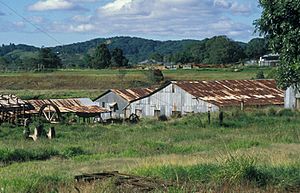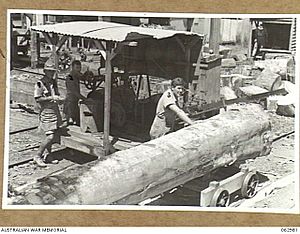Cairns Plywood Pty Ltd Sawmill Complex facts for kids
Quick facts for kids Cairns Plywood Pty Ltd Sawmill Complex |
|
|---|---|

Butter box factory at Cairns Plywood sawmill
|
|
| Location | 25 – 33 Eacham Road, Yungaburra, Tablelands Region, Queensland, Australia |
| Design period | 1900 – 1914 (early 20th century) |
| Built | 1910 – 1980s |
| Official name: Cairns Plywood Pty Ltd Sawmill Complex, Cairns Plywood Limited, Eacham Sawmills, Williamson Brothers Sawmill | |
| Type | state heritage (built, archaeological) |
| Designated | 21 October 1992 |
| Reference no. | 600481 |
| Significant period | 1910-1980s (fabric) 1910–c. 1988 (historical use) |
| Significant components | shed/s, crane / gantry, objects (movable) – forestry/timber industry, tramway, machinery/plant/equipment – forestry/timber industry, mounting block/stand, veneer mill, drying shed, kiln, butter box factory, office/administration building, slab/s – concrete, moulding shed, furniture/fittings, chimney/chimney stack, forge/blacksmithy, workshop, railway |
| Lua error in Module:Location_map at line 420: attempt to index field 'wikibase' (a nil value). | |
The Cairns Plywood Pty Ltd Sawmill Complex is a special historic site in Yungaburra, Queensland, Australia. It's a former sawmill that helped shape the local area. It was built between 1910 and the 1980s. This sawmill is also known by other names like Cairns Plywood Limited and Williamson Brothers Sawmill. It was added to the Queensland Heritage Register in 1992 because of its important history.
A Look Back: The Sawmill's Story
How the Sawmill Started
The Williamson Brothers built this sawmill in 1910. It was a great location because the railway had just reached Yungaburra. This meant they could easily send timber to Cairns. The sawmill was first called Eacham Sawmills. Later, in 1940, it became Cairns Plywood Pty. Ltd.
Timber and Trains
The Atherton Tableland area used to be covered in thick rainforest. People found many useful trees there, especially for making furniture. But moving the heavy timber was hard. Early timber cutters used bullock or horse teams.
When the railway line from Cairns reached the Tableland, everything changed. It became much easier and cheaper to process timber. Sawmills started popping up in towns like Ravenshoe and Atherton. They supplied timber for mines and new buildings. The Tablelands became famous for its beautiful timber, like cedar and maple.
In 1910, the railway arrived at Yungaburra. This led to a boom in the town. The Williamson Brothers built their sawmill right next to the new Yungaburra railway station. The sawmill not only used the railway to move timber, but it also provided wood for building more railway lines.
New Roads and New Products
In 1926, the Gillies Highway opened. This road connected Yungaburra to the coast. It made it easier for trucks to move timber, replacing the old bullock teams.
Around this time, the sawmill started making new products. In 1933, a large machine called a Capital Lathe was brought in from the USA. This machine could peel thin layers of wood called veneers. By 1940, the business was renamed Cairns Plywood Limited. They started making veneers and plywood, which became very popular.
Butter Boxes and Borax
The sawmill also had a special section called the Butter Box Factory. It made wooden boxes for the Malanda Butter Factory. This factory was very important for the dairy industry in the area. However, the butter box factory stopped making boxes after 1963. The machines were too old and couldn't make money anymore.
The sawmill also had a "borax plant." This was used to treat timber with a chemical called borax. This treatment protected the wood from tiny insects called borers.
The Sawmill's End
In 1963, the railway line to Yungaburra closed. This meant the sawmill no longer had a direct train link to Cairns.
The main work of the mill in its later years was peeling veneers. The sawmill kept making timber for sale. However, the mill eventually closed down. This happened because the Wet Tropics Rainforest was listed as a World Heritage Site in 1988. This listing meant that cutting rainforest timber was no longer allowed. The sawmill burned down in the late 1980s.
What You Can See Today
The Cairns Plywood Sawmill site is quite large. You can still see many parts of the old mill, even though it's not working anymore.
The Main Mill Area
Where the main sawmill once stood, you can see concrete foundations, a tall steel chimney, and parts of old boilers and steam engines. These show where the powerful machines that ran the mill used to be. The tall metal chimney is still a landmark you can see from far away.
The Office
The old Office building is at the front of the site. It's a single-story building made of silky oak timber. It has a classic early 1900s look with an awning at the front. Inside, you can still see the old sales counter and some shelves.
Moulding Shed and Borax Plant
The Moulding Shed was used for shaping timber. It has a timber frame and a corrugated iron roof. Inside, there are two kilns, which were like big ovens for drying wood. Next to it is the Borax Plant, a large steel box where timber was treated. You can still see parts of the old railway tracks that once led from this building to the railway station.
The Workshop
The Former Workshop is a rectangular building where repairs and maintenance were done. It still has many old tools and machines inside. You can see a drill press, a hacksaw, grinding wheels, and even a large metal lathe. There's also a blacksmith's area with a forge and a small chimney.
The Plywood Mill
The Former Plywood Mill is a very large building. It's mostly an open space with some smaller areas inside. You can still see railway lines crossing the floor. This is where veneers and plywood were made. You might spot old rollers, presses, and saw tables here.
The Veneer Mill
The Veneer Mill is another huge timber building with a steel roof. It has a raised concrete floor. Some of the posts holding up the roof are made from very large timber logs. This is where the thin layers of wood (veneers) were peeled.
The Butter Box Factory
The Butter Box Factory is a timber-framed building with corrugated iron walls and roof. Inside, you can still see the machines used to make wooden boxes. These include saw tables, a brand stamping machine, and a guillotine.
Drying Kilns
The Drying Kilns are timber-framed buildings used to dry the wood. They have special rooms lined with timber and pipes that carried steam or hot water to dry the timber. You can still see parts of the internal railway and timber carts that were used to move wood into the kilns.
Old Tramway Tracks
You can also see bits of the old internal tramway tracks scattered around the site. These tracks were used to move timber and materials between the different parts of the sawmill.
Why It's Important
The Cairns Plywood Pty Ltd Sawmill Complex is listed on the Queensland Heritage Register for several reasons:
- It shows history: It helps us understand how the timber industry grew and changed in Far North Queensland. It was a major employer and important part of the local economy for many years.
- It's unique: The sawmill has a rare collection of old equipment, including steam and electric machinery. It also has a special set of machines for making butter boxes, which connects the timber and dairy industries – both very important to the Atherton Tablelands.
- It looks good: The industrial look of the chimney, machines, and sheds has its own beauty. The old office building also shows off the style of timber architecture from the early 1900s.
- It's important to the community: The sawmill was the main employer in Yungaburra for a long time. Many local families worked there, so it has a strong connection to the people of Yungaburra and the timber cutters who worked there from 1910 to the 1980s.


